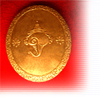 |
Related
Instittions The Oriental Manuscript Library, University of Kerala |
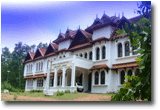 |
Kerala
has been preserving and propagating Sanskrit literature and culture
from time immemorial. Efforts at various levels, both concerted and
isolated, were made in this respect at various times. The Oriental Research
Institute and Manuscript Library of the University of Kerala is one
of the most prestigious |
departments
under the University of Kerala has been one of the major institutions which
spearheads the preservation activities.Its
origins go back to the illustrious Maharaja of Travancore, Swati Tirunal (1829-1846).
A great Kerala scholar by the name Sankaranatha Josier who had been serving
Ranjit Singh,the Sikh ruler of Punjab, came to Trivandrum on his services
being requisitioned by the Maharaja for appointment of the Chief Judge of
the Sadr Court. Josier presented the Maharaja with a collection of rare manuscript
dealing with a variety of subjects.The Maharaja who was fully conscious of
the immense value of such manuscripts as source material for cultural history,
ordered the collection and copying of manuscripts of literary and Sanskrit
works on a systematic basis. The collection so made by him formed the nucleus
of the Palace Grandhapura. Substantial additions were made to the stock
of manuscripts in the years to come. A separate department itself was set
under the Government during the reign of Maharaja Mulam Tirunal (1885-1924).
In 1908, a curator was appointed to be in charge of the department and to
attend to the work of publishing the Sanskrit works in the Travancore palace
collection. Its first curator was Mahamahopadyaya Dr. T Ganapathy Sastri
who was a renowned name in the world of scholarship. He unearthed and published
for the first time the thirteen plays of Bhasa. It was an epoch- making event
in the world of Indology and brought glory to the institute. In 1924 the curator’s
office for Malayalam Publications was established with Ullur. S. Parameswara
Iyer (then acting Chief Secretary of the state) as its Head. In 1930, these
departments were amalgamated to form a department for the publication of Oriental
Manuscripts. After the establishment of the University of Travancore in 1937,
a department for collection of manuscripts was started in 1938. The palace
library collection was donated into it. In January, 1940, the Department
for the publication of Oriental Manuscripts under the Government was amalgamated
with the Oriental Manuscripts Library of the University and Vaidyasasthranipuna
Dr. L. A. Ravi Varma was appointed Honorary Director of the Library. By the
mid- forties, it had a collection of 20,900 manuscripts, 1,440 transcripts
and 2,518 printed books in its stock. The bulk of the collection was in the
form of palm-leaf manuscripts collected from Nambutiri Illams, Manas,
Madhoms and private families in Kerala.
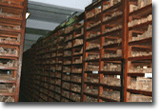 |
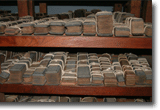 |
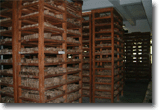 |
The collection of manuscripts made such headway in the succeeding years. The Silver Jubilee volume of the University (1963) put the total collection till then at 50,000. During 1944-45 the Library was entrusted with the publication of Ayurveda manuscripts, hitherto undertaken by the Ayurveda department. A quarterly journal for the publication of Sanskrit work was also started. It may be recalled that Dr. Karan Singh, the then Union minister for Health, who visited the library on February 2, 1976 had made the following observations about the Library in the Visitor’s Book- “I am delighted to see this magnificent collection of ancient manuscripts which constitutes a valuable national heritage.” Currently the Library has a collection of about 65,000 works. A large bulk of this is palm leaf manuscripts, collected from private families from all over Kerala. Orientologists and Manuscriptologists have all expressed the view that Kerala is a fertile ground for the collection of manuscripts on various subjects in indology. Kerala has been fortunate to have great patrons of literature and many of them have also been great contributors to it. Further the cultural traditions of Kerala demanded that leading families should organize and keep libraries of manuscripts. It is a fact that there are still several sources in this state, which will yield rich collection of manuscripts if properly tapped. In the matter of collections it is expected that continuous work will help to increase our manuscripts collection and efforts in this direction are being carried out by the Department. Among the palm leaves, 44,000 are in Sanskrit and about 10,000 in Malayalam. The rest are in Tamail, Bengali, Telugu, Kannada, Hindi, Burmese, Assamese ,Oriya and Indonesian. The scripts used are Vattezhuthu, Malayalam, Grandha Tamil, Devanagari, Nandi Nagari, Bengali, Kannada, Telugu, Assamese, Burmese and Oriya. The most common way of writing on a palm leaf is incision with a stylus. There are two palm leaf manuscripts in the library which are written with ink, the well known Aryamanjusrimulakalpa being one of these. The manuscripts in the library cover a wide variety of subjects. In fact they deal with all branches of discipline in Indology such as Vedas, Upanishads, Tantra, Mantra, Itihasa, Purana , Grihya Karma Suthras, Vedangas, Vyakarana, Nirukta, Jyothisha, Vaidyam, Nyayam , Mimamsa, all branches of Literature, Sculpture Samudrika and so on. Some of the rare manuscripts in the library deserve special mention. The Chitra Ramayana (Ramayana in pictures) is a rare manuscript in palm leaf. The scenes of the Ramayana from the Balkanda to the Yuddha are drawn with stylus. It contains 96 leaves of the size 34 x 4 cms. It is about 500 years old. There is a paper manuscript which contains pencil sketches of all the scenes of Ramayana with descriptions of the pictures in Tamil. There are two other palm leaf manuscripts which depict an episode each from Ramayana and Mahabharata, Acquired from Indonesia, which were donated to the library in 1985 by K.M Kunnampilly, former Indian Ambassador to Indonesia. A garland made of palm leaves cut into the size of beads in which a chapter of the Devi Mahatmya is written is a very curious piece of art work in the possession of the library. A manuscript entitled Maranasastram written by Kamala Muni in minute Tamil script deserves special mention. A palm leaf of the size 21 x 35 cms contains as many as 30 lines on one side. A manuscript has ivory protective covering on which are beautifully carved some scenes from the puranas.
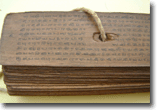 |
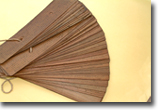 |
The Library has brought out numerous critical editions of classical works
in Malayalam like Adhyatma Ramayanam, Nalacharitham Attakkatha, Ramayanam
Attakkatha Kannassaramayanam and Ramacharitham. From very early
times, it has been publishing books under two series, viz, the Trivandrum
Sanskrit series and the Trivandrum Malayalam series. Under the Sanskrit series
has come out some epoch –making publications. As already mentioned, the discovery
and publication of the Bhasa plays in 1912 created much interest among the
scholars of Indology all over the world. Regarding the significance of the
discovery Prof. M Winternitz observes as follows :-“ If it should finally
be proved that Bhasa cannot be the author of these plays, they will always
have to be counted among the most valuable treasures of Indian literature
and we have every reason to be thankful to Ganapathi Sasthri who has unearthed
these treasures for us.” Kautilyas’s Arthasasthra in Sanskrit with Malayalam
commentary is another important contribution to Sanskrit studies. Prof. Franklin
Edgerton has observed, “Dr. Ganapathy Sasthri’s edition of Kautilyas’s Arthasathra
, with commentary is decidedly the best edition of that all – important
work in existence , the printed work is superior from critical scholarly
standpoints, to other editions, and commentary is of primary and very great
importance for the interpretation of the very difficult text.” The Malayalam
Commentary on the Artha sastra is one of the earliest commentaries in in any
Indian language. The Sanskrit Mattavilasaprahasana by Mahaendra Varman
Pallava(600-630AD) which has been immensely popular with the Chakiars
of Kerala for the performance of Koothu was also first published from
Manuscripts Library in the Sanskrit series
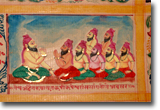 |
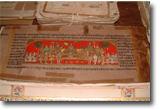 |
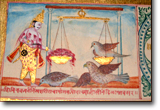 |
Samples of colorful Manuscripts
The functions of this library are: (1) Collection and preservation of manuscripts and (2) publication of manuscripts. It has published till now 200 works in the Trivandrum Malayalam series. Special mention may be made of the publication of the 13 plays of Bhasa under the able editorship of the late M. M. Ganapathi Sastri, the first Curator of the Department of Publications. The Bhasa plays long mentioned in Sanskrit literature for over 2,000 years were at first unearthed in Trivandrum and published from here. The importance of Bhasa as a playwright, the completeness and perfection of the plays themselves, the indebtedness of post Bhasa Sanskrit Drama to Bhasa and his plays have all made our publication of Bhasa’s work an event in Indian research and publication.
Another work, which deserves mention in this connection is the Aryamanju Srimula Kalpa a Bidduhist work, which throws a great deal of light on the history of India from 600B.C to 700 A.D. The publication of this work from this institution xcaused further research into this period in Indian history by noted historians like K.P.Jayaswal and historians have expressed their indebtedness to this work which was till then available only in the form of a Chinese translation. A major publication in the Malayalam series is a commentary in Malayalam on Kautalya’s Arthasasthra. Being one of the earliest commentaries on the Arthasasthra in any Indian language, it throws light on the reconstruction and interpretation of passages in the original text itself.
Ullor S parameswara Iyer, Kolatheri Sankara Menon, K. Samba Siva Sasthri, Mahadeva Sasthri, Dr. L.A. .Ravivarma, Prof. V.A. Ramaswami Sasthri, Dr. P.K. Narayana Pillai, K.S Mahadeva Sasthri, Sooranad P.N. Kunjan Pillai, Dr. K. Raghava Pillai, Dr. K. Appukuttan Nair, Dr. T. Bhaskaran and Dr. K Vijayan. Dr. P. Visalakshi, is the currently the Director-in-charge.
Former directors:
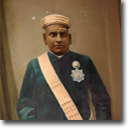 |
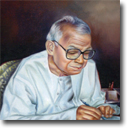 |
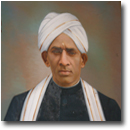 |
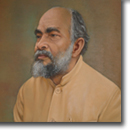 |
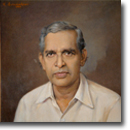 |
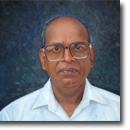 |
4. LIST OF MAJOR WORKS AVAILABLE IN THE MANUSCRIPTS LIBRARY
-13 Sanskrit plays of Bhasa
-Aryamanju Sreemula Kalpa (Buddhist work)
-Kautilya’s Arthasasthra (Malayalam Commentary)
-Chithra Bharatham (Indonesian)
-Chithra Ramayanam (Malayalam)
-Krishnan Sthuthi (Assamese)
-Bhagavadgita (Telungu)
-Mahabharatha (Maratti)
-Saraswathi Kantha Bharana (Interpretation of Panini’s work)
-Brhadjjatakavivaranam
-Attiyaramatham Granthavari
-Daivagamam Bhasha
-Mahabharatha
-Jatakaphalavisesanirupanam
-Bhagavatastotrasamuccaya
-Kandapuranam
-Rupaprasna
-Ramayanachitra (in book form)
-Aksaraprasna
- Marakaprakarana
-Devimahatmyam

